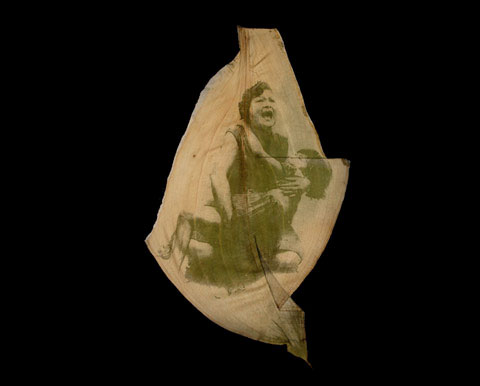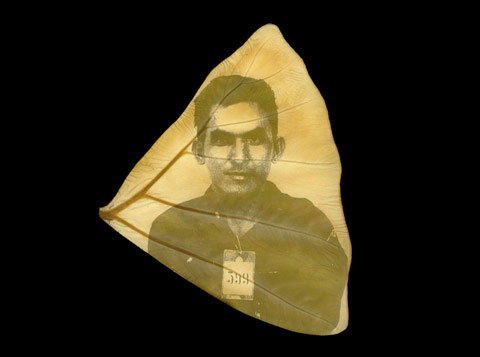Artist Binh Danh Prints Arresting Photos of Vietnam on Delicate Leaves
posted Tuesday, April 3, 2012 at 1:15 AM EST
 Photographer Binh Danh prints his photos on leaves he gathers from his mother’s garden. They are fragile, brittle images of an imagined life in the chaos of post-war Vietnam that uniquely combine photography and organic materials.
Photographer Binh Danh prints his photos on leaves he gathers from his mother’s garden. They are fragile, brittle images of an imagined life in the chaos of post-war Vietnam that uniquely combine photography and organic materials.
In 1979, Danh’s parents were among thousands of refugees fleeing the turmoil of Southeast Asia. He was two at the time, too young to remember life there. But once they settled in Southern California, his family home was filled with stories and reminiscences of the war.
Growing up in Southern California, Danh graduated from San Jose State University with a Bachelor of Fine Arts in photography. At the age of 25, he became one of the youngest artists ever invited into Stanford University’s prestigious Master of Fine Arts program.
Since then, Danh has had a number of exhibitions of his photography, most of which focus on the Vietnam War. Danh has said he refers to the war and to death in his art by using photographs to “bring up and start to fabricate memories” of life in Vietnam.
In the words of one critic, his work has the ability to “summon up revulsion over present violent conflict in the world without direct topical reference.” And, as another described his photos, they “evoked wars past and present with an unforced economy almost unparalleled in political life.”
In the “The Iridescence of Life” exhibition, Danh goes beyond the political, delving deeply into the perishable nature of memory itself. By printing his images on delicate plant leaves, he evokes the effervescent nature of existence, revealing death as part of the nature of things.
These leaf images have been called “Chlorophyll” prints and Wikipedia notes that Danh invented this process, which is not quite correct. The effect of light on organic materials had been well known for centuries and used by artists to create “shadow” images on substances such as leaves and potato starch.
How It's Done
 Binh Danh’s creates his chlorophyll prints by gathering fresh leaves from his mother’s garden. He places photographic negatives on top of the leaves and covers them with a piece of glass. The leaves are exposed to sunlight for several days and as they dry out, a positive image is formed on their surfaces.
Binh Danh’s creates his chlorophyll prints by gathering fresh leaves from his mother’s garden. He places photographic negatives on top of the leaves and covers them with a piece of glass. The leaves are exposed to sunlight for several days and as they dry out, a positive image is formed on their surfaces.
Danh takes the best ones and casts them in a solid block of resin. By encapsulating the organic “Chlorophyll photographs” in polymer, he stops further “development” and “fixes” the image.
Embedding delicate leaf images in resin gives Danh’s art a particular resonance as it combines the natural world with a modern technology process. For him, it is a way to express his search for “hidden stories embedded in the landscape.”
Binh Danh’s work has been included in important exhibitions at museums across the country. It is in the collections of the Corcoran Art Gallery, The Philadelphia Museum of Art, the deYoung Museum, and the George Eastman House, among others. In 2010, he received the Eureka Fellowship from the Fleishhacker Foundation. He is represented by Haines Gallery in San Francisco, CA and Lisa Sette Gallery in Scottsdale, AZ. He is based in San Jose, California.You can see more of his photographic art at www.binhdanh.com.
